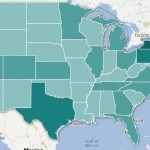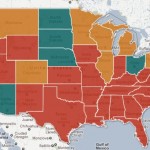Map
New ‘Granite Fund’ To Put Local Capital In The Hands Of N.H. Startups

This map traces the last year of venture capital deals across the country. In New Hampshire, a collaborative venture fund -- managed by Borealis Ventures with money from the state -- will soon be moving local capital into the hands of local innovators. Continue reading
How State Budget Cuts Affect Your Property Taxes

401k / Flickr
Researchers crunched tax data and found state budget cuts have resulted in higher local taxes over time
A new report finds that Granite State communities are leaning more and more heavily on property taxes. Examining data from 2007-2010, the New Hampshire Center for Public Policy Studies found:
“Total municipal appropriations per person have leveled off considerably over the past three years compared with pre-recession trends. At the same time, we see that two main sources of municipal revenue–state aid and property taxes–have been under strain, with per capita state aid to cities and towns down roughly 14 percent from 2007 to 2010. Total property valuation per capita remains essentially flat over that same period, after several years of annual increases.” Continue Reading
Find Out Where You Are In The 99 Percent

Todd Blaisdell / Flickr
The Occupy movement has popularized the notion of "the 99 percent." An interactive map breaks that figure down further
If you move past the front-page headlines, work your way past the daily business news, and descend into the depths of the New York Times website, there’s a reasonable chance you’ll encounter a cool, interactive infographic.
And it just so happens that today, we’ve found what we believe to be one of the Times‘ niftiest offerings to date. They’ve posted an interactive map that allows you to plug in your salary, and move your cursor over various states and counties to compare how your personal wealth (or lack thereof) stacks up. As an example, here’s a screen shot of what we found when we entered in New Hampshire’s median salary of $61,042 (which is among the highest in the country).
Tracing NH’s Slog Toward Economic Recovery
A recent piece in the New York Times lays out what many Americans already believe:
For much of the country, economic recovery is a ways off. Reporter Michael Cooper writes:
“Less than a tenth of the nation’s metropolitan areas have regained the jobs they lost in the economic downturn, according to a report…
Only 26 of the nation’s 363 metropolitan areas had recovered their lost jobs by the end of 2011, and only 26 more are projected to recover them by end of this year, according to the report, which was commissioned by the United States Conference of Mayors. It will take at least five years for the 80 hardest-hit areas to recover the jobs they lost, the report forecast.” Continue Reading
How NH Counties Voted (Based On Economic Drivers)

Emmanuel Dunand / AFP/Getty Images
Romney won the NH primary by a healthy margin. We break down the county vote by economic drivers
This year, NHPR’s GOP primary coverage took on a strong national flavor, broadcasting to listeners all over the country. Among the network’s expanded audience were WNYC listeners in, well…NYC. And in the spirit of inter-station cooperation, the good folks at WNYC and Patchwork Nation used AP polling data to put together a county-by-county map of election results.
What interested StateImpact about this map is that it also classified each county according to its main economic drivers.
Before we get rolling, though, just one brief note about the map. To see statewide totals, move your cursor outside of New Hampshire. To get more details on how WNYC/Patchwork Nation determined the main economic driver of a county, just click on the colored icon in the map key. You’ll see a nifty pop-up including census data, poll numbers, and other info.
We’ve got a written break-down below the map. Continue Reading
The States With The Best And Worst Wage Laws For Home Health Workers

President Obama is pushing for a change to federal labor rules covering payment and overtime for home health workers. We've cobbled together White House data on which states do--and don't--offer minimum wage and overtime for home health workers. Continue reading
How A European Recession Could Hurt Key Export States–Including NH

Dennis Skley / Flickr
How much could a Eurozone recession hurt New Hampshire? We explain after the jump
Recently, Wells Fargo Securities released a short report offering a state-by-state look at the places that could be hardest-hit by a potential European recession. Since New Hampshire has carved out a healthy niche for itself in the high-tech components export market, we thought this report might be of interest to our StateImpact readers.
For its analysis, Wells Fargo looked at each state’s exports to Europe by percent of GDP, and then ranked them on a scale of highest-to-lowest risk. Among the report’s key findings are:
- Only 1.97 percent of overall US GDP is made up of exports to European markets.
- States with the highest exposure to a possible European recession primarily export commodities. For example, Utah, with its gold and silver exports, and West Virginia, which sends coal across the Atlantic, depend much more heavily on European markets than many other states. More than 5.5 percent of Utah’s GDP is tied to European exports, and 3.9 percent of West Virginia’s GDP is tied to those markets. Continue Reading
Map: Where Lowe’s Is Closing
Yesterday, Lowe’s announced it’s closing 20 under-performing stores across the country. Based on the company’s press release, we’ve generated this map of cities that will lose a Lowe’s. The Northeast by far took the biggest hit. The swath of country from New Jersey to Maine accounts for 45 percent of closures. And among all the states, New Hampshire is losing the most stores. Between closures in Claremont, Hooksett, and Manchester, 279 full- and part-time employees will lose their jobs.
You can check out the larger size of this map by clicking the link below.
View Where Lowe’s Closed in a larger map

